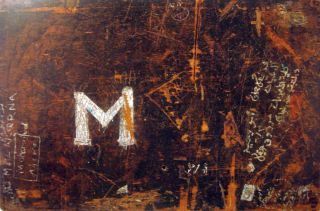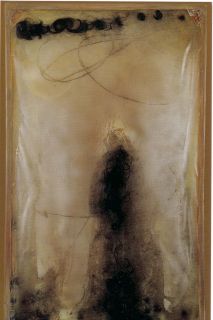

From top to bottom: Dialectique: school desk from Mecca, Zincograph 1.
|
Mahdi Al Jeraibi (1969) works as an art teacher in Mecca where children write and scratch, but hardly draw on their school desks. Really, I wondered: who or what for 25 years made these children not mix rabbits and automobiles with their doodle writing and daydream scratching? It is what we should do: wonder and ask. It is the artist who wants us to. About the school desks which he collected and presented as readymades for the audience to place on a wall. 'ALL WERE HERE,' it read about the desks and note that the exhibition was in Jeddah and not in Mecca. The artist wants dialogue about our memories. He presumes we can do so in a Socratic manner, disagreeing and convincing each other, using points of reference which work for us all. He wants us to explain and argue about traces of our past, which he simply picks up from the floor or out of the school's backyard. In a way he wants us to go back in time as if we were to cut off our hair; and then he will collect it and remind us that we will grow it back again, unable to change its colour or substance. It changes only slowly with the passing of generations. So is there no point in painting it for any future? Actually there is. Dark haired people who paint their hair blond, lure their partner's blond hair genes into changing direction. So I read somewhere in a scientific paper. In the end the dialectic argument aims to convince. But on the rational level, in the educated world, in the world of Mahdi Al-Jeraibi, in the world of Saudi Arabia's first conceptual artist, we should be optimistic about the potential of art to achieve faster results. Convincing in Al Jeraibi's Mecca is possible on, well, a moments notice, simply by listening and allowing yourself to be convinced. Of his art perhaps. Of his sombre Zincographs which are as far removed from golden palms in Dubai hotels as one can possibly imagine. They are of the moon, rather than of the sun - there is no real zinc involved - shining a dark light on the crossing over of religious rituals of pilgrims, superstitions which survive in Mecca and a fear we have of a know known future of using DNA to recreate. The Zincographs are sculptered paintings: large wooden frames in which the artist has fixated hair he has collected of a variaty of people in a thick plate of hot wax. They are reminicent of ancient Egyptian wax portraits to a conceptual mind only. The hair he used he collected both from anonymous pilgrims - beware of Mecca barbers selling clones - and from individuals he knows well and managed to convince. As one of them is said to be his wife, there is a question that arises in the mirror of memories. Will Al Jeraibi, when his wife's hair is eventually used to clone, be the first Pygmalion to have succeed in giving true life himself to a women of his perfect imagination? We should grant her that. The artist himself is the object of imagination too. The Foundation Al Mansouria who has supported him against the dragons of misunderstanding and disinterest has put him forward as a 'model for the quest of the young and serious.' We should grant them that too. (September 30, 2009).
Mahdi Al Jeraibi. Fondation Al Mansouria Catalogue by Jean-Claude Le Gouic, Paris 2001. Edge of Arabia. Exhibition book by Henry Hemming, London 2009. |
|
From top to bottom: Dialectique: school desk from Mecca, Zincograph 1. |